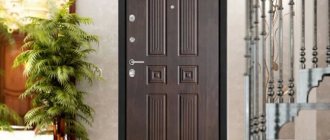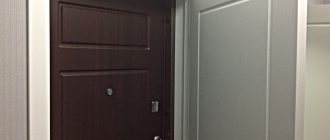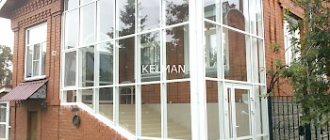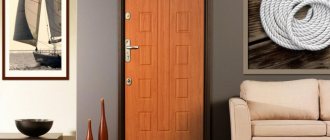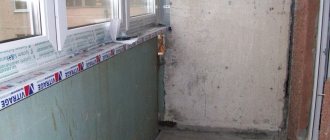A metal door freezes: what to do? The answer to this question lies in a whole set of measures that should be taken to eliminate such a problem. Most often, it is necessary to improve all structural parts that have been affected by temperature changes. You will learn how to do this further.
The problem of freezing of the front door is often encountered among owners of private houses.
How to determine if there is a problem
Not everyone notices in a timely manner that their iron door is freezing, and therefore much more work has to be done in the future. Constant contact of surfaces with moisture and temperature changes affect the condition of all structural parts. Often, the first thing the canvas begins to swell and the edge to peel off. If decorative panels, laminate or veneer are glued onto it, they will immediately become unusable, swell and fall off.
It’s not just the appearance of the door that suffers. Framing elements also deteriorate: frame, slopes, thresholds, trims. If the front door freezes, over time the lock may become jammed and the movement of the door leaf may be limited. Even an iron structure can become deformed under the influence of such changes in conditions. Gradually, moisture will spread its influence to the finishing of walls and floors. Fungus and mold can develop on wooden parts and concrete.
Most often, the problem is associated with imperfect design and, first of all, the appearance of the door suffers from this.
You can determine if there is a freezing problem by the following signs:
- jamming of locks and hinges in cold weather;
- drafts;
- presence of condensation on the room side;
- swelling of the lining;
- the door freezes around the perimeter and becomes covered with a layer of frost.
If at least one sign is detected, you need to act immediately.
Methods for eliminating condensation on a metal door
It should be noted that a high-quality door block is not cheap - from 25,000 rubles, and if it is not possible to buy a new one, then you need to put in order the one that is already there. To do this, there are several methods that improve the thermal insulation properties of the door structure.
The first and most reliable is to install a second wooden or plastic door on the side of the room. This will create a temperature buffer zone and prevent heated air from coming into contact with the cold surface. An important point when creating a so-called mini-vestibule is tightness - the additional door block must be free of cracks and gaps. This method works great and eliminates condensation. An expensive alternative to a mini-vestibule can be an external extension, which will also create a buffer zone.
Condensation on a metal door: 5 methods to solve the problem
Condensation on a metal door: 5 methods to solve the problem
The second method is complete insulation of the canvas and the box. Here you need to act comprehensively, namely, carry out a number of activities. One or two actions will not bring the desired result. To obtain the maximum effect, it is advisable to carry out work in warm weather, since it is better to remove the door leaf.
What should be done
The third method involves the use of energy-consuming appliances. For severe frosts, you can create additional heating of the structure by installing a heated floor cable in the slopes or a thermal curtain above the door. It must be said that the electricity consumption will increase significantly, especially when using a thermal curtain, but since the method is working, one cannot remain silent about it. A thermal curtain, for example, will perfectly protect the gates or roller shutters of a built-in garage.
The fourth method says - do not neglect the outer skin of the door. Metal has high thermal conductivity, which is 300 times higher than that of wood. The best option would be to cover the door leaf and frame with clapboard. Reflective insulation can be placed between wood and metal. This will reduce heat loss, especially in cold windy weather.
Possible causes of freezing
Every owner will be interested in why the front door freezes. There may be several reasons. Most often this is due to the design of the opening itself or the use of low-quality materials.
Improper installation of the front door can cause freezing
Reasons for freezing of entrance doors:
- Significant temperature difference. If it is frosty outside and the heating appliances are running in the house, there will be a significant difference between the temperature of the environment on the outside of the canvas and the inside. Condensation accumulates in the room and, as it cools, freezes.
- Climatic changes. With sharp fluctuations in ambient temperature, the formation of condensation and frost is also possible.
- High thermal conductivity of iron. The metal door quickly cools down and thus allows cold from the street into the house.
- Shrinkage or lack of insulation for the fabric. Ideally, the product should be insulated, but not all manufacturers do this. If low-quality materials are used, over time they lose their properties and do not have a beneficial effect.
- Insufficient door thickness. Thin iron and a minimal layer of cladding do not pose a significant barrier to low temperatures.
- Gaps and cracks in the opening structure. These defects may remain from the time of installation work or arise during the operation of the door. The cold passes through the cracks and the wind blows. Precipitation can enter the room through them.
- Poor sealing of joints. The rubber around the perimeter of the loot provides protection from drafts and frost, but over time it wears out and loses its properties. In addition, it is not always installed.
- Deformation of opening elements. Due to long-term use, rough handling or uneven load distribution, the opening parts may become damaged, as a result of which important parts of the structure are deformed and gaps are formed.
- Installing just one door is not enough. In particularly cold areas, as well as in private homes, one door is not always able to protect the room from low temperatures, and is therefore subject to freezing.
The cause of condensation and its consequences
Condensation, wherever it occurs, is an undesirable phenomenon and quite destructive for enclosing structures. The main harm that condensation causes to metal is corrosion. Rust eventually destroys the canvas and the box. Doors, especially low-quality ones, are made of thin metal and if they are allowed to rust, their protective functions will decrease after 5-7 years. And also rust will destroy the coating - paint on a canvas exposed to corrosion will fall off in pieces.
During severe frosts, condensed moisture freezes, forming frost and ice on the door frame and door leaf. Ice can destroy plaster and damage paint on slopes. If the door is finished with MDF panels or lining, these materials, when exposed to moisture and ice, will become damp, deformed, change color, and lose their decorative qualities.
Another significant disadvantage of the appearance of condensation is the increased humidity in the hallway. Water flows onto the floor, forming puddles, and is also absorbed into the slopes, causing the appearance of mold, which is extremely dangerous to human health. All this also creates a persistent smell of dampness in the room.
Replacing insulation
So, what should you do if your front door is freezing? First of all, it is necessary to determine the most likely cause of the problem. In most cases, it is connected precisely with the canvas itself. A high-quality door should be well insulated. Usually this work is done at the production stage, but if you remodeled the door or even designed it yourself, the responsibility for carrying out insulation lies solely with you.
It should also be taken into account that over time, the material of the internal filling of the canvas sags and collapses. As a result, its beneficial properties are also lost. If you have never encountered the problem of freezing before, in 5-10 years it may suddenly overtake you. To prevent this from happening, it is recommended to do a preventive update of the insulating layer.
Replacing the insulation with a more efficient one will help correct the freezing problem.
To replace the insulation in an iron door, you need to remove it from its hinges and disassemble the door leaf. Depending on the design, the insulation can be located inside a solid product or under an additional panel. It is very good if there are several stiffening ribs inside, they prevent complete subsidence of the material.
Bulk, soft and hard types of substrates can be used for insulation. Dry bulk materials are placed in non-separable models. In other cases, sheet fillers are used. Soft ones are significantly inferior to more rigid insulation materials, as they quickly lose their shape. Therefore, foam blocks would be the best option.
In order to install the insulation, it is recommended to use an additional heat-reflecting substrate and adhesive mixtures to fix the position of the sheets. Cut the material so that it fits perfectly into its place in the door body. The heat reflector and foam are glued to the metal. To do this, it is convenient to use polyurethane foam, which will close all joints and minimize the presence of cold bridges. After the insulation has adhered to the surface, it can be covered with a panel and the door returned to its place.
Thermal protection of the door leaf
Inexpensive door frames most often do not have an additional layer of insulation.
Important! In order for the design to serve faithfully, it is better to modify it immediately after purchase.
In construction stores there are ready-made insulation kits for the front door, where all the components are already measured and cut according to the required dimensions. However, most of these kits include heat insulators with low efficiency (foam rubber, synthetic padding), which do not give the desired result.
Door trim kit
For high-quality door insulation, the following materials are used:
- Mineral or basalt wool. The thermal conductivity coefficient of cotton wool is low, as is its cost. This heat insulator is easy to install; there is a choice of types of material (rolled, slab-shaped). The disadvantage is high hygroscopicity, as a result of which condensation may appear inside. When insulating a door with cotton wool, it is worth using an additional layer of waterproofing.
- Foam plastic, extruded polystyrene foam. When making expensive door frames, such materials are often already embedded inside. Expanded polystyrene does not absorb moisture, has low thermal conductivity, is durable, and retains its shape. It also has a disadvantage: due to its rigidity, it will not be possible to fill holes in the structure with it without gaps. It is best to use expanded polystyrene in combination with polyurethane foam.
- Izolon, or foamed polyethylene. The material consists of many air-filled cells. The stores have regular and foil types of products. The thermal conductivity coefficient of isolon is low, but it is quite thin, so it is worth combining it with other thermal insulators. Another material, penofol, has similar qualities.
- Polyurethane foam. This is quite expensive, but very high quality insulation with high density and long service life. Polyurethane foam can simply be glued to the surface of the door, however, the cracks will have to be additionally filled with polyurethane foam.
Knauf insulation for entrance doors
Increasing the thickness of the web
What to do if even after internal insulation the metal door still freezes? Such cases are not uncommon, because not all canvases meet the standards of a particular climate zone. The door may not be thick enough. What to do in this case?
A metal entrance door should not only be durable, but also beautiful. For this purpose, various materials are used to cover the surface of the canvas. Most often in modern models you can find an overlay of MDF panels. This material is quite durable, resistant to various types of influences, and is also capable of providing additional sound and heat insulation. Decorative MDF panels are attached to the canvas, and therefore when they freeze, they will be the first to suffer. That is why you should not skimp on finishing.
Sometimes the solution to the problem can be installing a thicker door leaf
Immediately upon purchase, make sure that their thickness is at least 20 mm. Such a sheet of fiberboard will not allow condensation to accumulate on the outer part of the sheet.
The thicker the layer of interior finishing, the greater the chance of keeping it dry.
The second way to insulate fabric using external cladding is soft upholstery. This method is especially often used to update old wooden entrance doors. To complete this you will need a soft substrate, a heat reflector and dermantine. To prevent the passage of cold, steam, and heat loss, a thin foil backing is placed on the door. A soft material is attached on top, for example, isolon - this is an excellent insulation, a worthy replacement for foam rubber. Upholstery is done using furniture nails and a solid piece of dermantine. To seal the porch, you can additionally build rollers around the perimeter.
About the functions of the door structure
It is necessary for the front door to become reliable protection not only from thieves, but also from various environmental factors. And you certainly can’t do without high-quality noise and heat insulation. After all, if the door is of poor quality, you will have to listen to different sounds coming from outside. A good metal structure will retain thermal energy inside the home. Therefore, it is important to choose a high-quality model or, as an option, to know how to insulate an iron entrance door.
On a note! Sometimes the door still freezes, even if it was installed by qualified specialists. A problem like this needs to be resolved quickly. First of all, you need to talk to professionals, describe the situation to them and discuss ways out of it. Below are the issues that apartment owners have to deal with most often.
Improved loot
Another reason why an iron door constantly freezes may be the imperfection of the frame itself. The presence of cracks, voids and crevices leads to cold air entering the room. At the same time, it condenses and settles on the side parts of the structure. As a result, the edge of the canvas, the box and part of the platbands freeze most intensely. This problem is dangerous because the door frame deteriorates when exposed to moisture. If wooden parts are used, they will likely become susceptible to mold, mildew, and rot over time. Other external cladding of the opening also becomes unusable: platbands, slopes, wall coverings.
What should I do to keep the cold out of the box? To do this, it is recommended to carry out a major overhaul of the frame of the opening and insulate the opening itself. First, you need to make sure that during installation all gaps and cracks in the wall that could have arisen during the work were eliminated. The door is temporarily removed from its hinges. Carefully remove the trims. If large gaps are noticeable between the wall and the box, it is recommended to fill them with insulation and polyurethane foam.
Please note: polyurethane foam is destroyed when exposed to sunlight. It crumbles and can lead to loosening of the structure, forming cracks and depressions, which will certainly affect the thermal conductivity of the box.
Small cracks in the frame and small gaps must be eliminated using sealant or putty. If the loot is made of wood and it begins to dry out, you can fill the cracks with a special primer or glue using a syringe.
After the work has been completed and the material has completely dried, install all the frame parts in place and hang the door. In general, insulation of the sill and threshold should be carried out at the stage of initial installation. However, even this does not guarantee the effectiveness of the measures, since over time the insulation sags and loses its properties. The metal tray must be protected from the interior by installing slopes or installing MDF panels.
What other measures can be taken
To insulate a freezing door as efficiently as possible, in addition to gluing polystyrene foam or expanded polystyrene, you can try to remove all cold bridges. To do this, you just need to fill the hollow metal elements of the door with polyurethane foam. In addition, you need to fill the areas where the door frame meets the opening with foam.
An effective way to change laws: what the poor people of Ancient Rome did for this
Dads need to be praised for staying at home with their children, but moms deserve it too
The period of active magnetic storms has begun: why are they dangerous and how to protect yourself
Also a good solution would be:
- stick sealing tape around the perimeter of the box;
- cover the lock with a special sliding lid;
- insulate the slopes with mineral wool or expanded polystyrene and then plaster them.
Sealing joints
What to do if the metal entrance door freezes around the perimeter of the leaf? Most likely, banal sealing of the joints is necessary. It involves installing an additional seal that will prevent frost and icy drafts from passing into the room.
The heat-protective function of a door directly depends on the quality of the seal placed at the joints of the door leaf and frame
Having such a gasket is a must, regardless of whether you suffer from a similar problem or not. The tape will protect you from cold, heat, odors and extraneous noise entering your home. It provides not only sound insulation, but also prevents heat loss.
The easiest way to make a backing is from a special rubber seal. It is a segment of small width, most often stepped, which adapts to the shape of the box. Sometimes a hollow rubber tube or foam seal is used. A more modern material is isolon. It can also be found on the market, it looks like foam rubber, but lighter and denser.
Both the elastic band and the foam strips are attached very simply. There is adhesive tape applied to the seal on the reverse side. It is necessary to glue the entire perimeter of the box, including its lower part with the threshold, where the canvas joins the frame. The elastic band should not interfere with the movement of the canvas, but at the same time ensure its tight fit without a single gap in the structure.
What to do if the front door freezes?
The problem must be solved before the lock, or hinges are damaged, or the box or canvas is misaligned. Otherwise they will have to be changed.
Let’s say right away: if the doors to a private house freeze, then the safest thing to do is to immediately replace them, and install thicker and insulated ones, or install another one. Especially if freezing begins during mild frosts: it happens that even at near-zero temperatures the door is already covered with frost. In severe frosts, the problem is greatly aggravated. In this case, any other methods will have little effect.
If freezing begins only during severe frosts (below -10°), and in your region very low temperatures do not last for several months, you can try to solve the problem using other methods listed below.
Thermal audit
To determine where the greatest heat loss occurs, it is advisable to illuminate the canvas, box and surrounding walls with a thermal imager. Heat loss is displayed on the screen in different colors, and a clear picture of the heat distribution across areas is obtained. This way you will see which part needs to be insulated (or you will understand that it is easier to replace the entire structure).
What does the front door look like when scanned by a thermal imager?
The approximate price for such an examination is from 1000-1500 rubles (if you take only the front door).
Buying an insulated door (with a thermal break)
If you have not installed doors yet, or are planning to change them, it is advisable to immediately install an insulated version.
How does it differ from a “regular” door:
- the canvas itself is thicker;
- there is a layer of insulation on the canvas, box;
- The tightness of the joints is better.
Another option is a door with a thermal break. There are voids inside it, “surrounded” by insulation.
The cost of a good insulated metal door starts on average from 30-40 thousand rubles, depending on the thickness and model.
Wooden door installation
Let us take a special look at the material of the door leaf.
After the turbulent “nineties,” our people believe that the safest door is a metal one. But they are mistaken: modern burglars, if desired, open the locks on any door, unless we are talking about super-expensive models.
Wooden doors do not have this problem with freezing , since wood conducts heat worse than metal. And if you install a model with a canvas 7+ cm thick, then it will not be easy to break it, and it will not freeze in frosts of -20-30°.
Of the minuses:
- lower strength;
- wood tolerates moisture less well: it can swell and crack (therefore, you definitely shouldn’t buy cheap wooden doors - they are unlikely to be impregnated with moisture and are unlikely to be painted well);
- Mold may appear on wood that is “unprotected” from moisture.
As for the price: a wooden door made of solid oak insulated (with foam plastic) with a metal sheet sewn into the door will cost about 60 thousand rubles. There are simpler options - from 40-50 thousand.
Insulation of door leaf and frame
To prevent heat from escaping through the door leaf or frame, you can:
- eliminate gaps and voids between the doorway and the frame;
- replace the seal along the entire door frame with a thicker layer;
- insulate the canvas itself (stick a heat insulator on it, the easiest way is polystyrene foam or mineral wool).
Craftsmen who install a door usually seal the gaps between the frame and the walls with construction foam. But gradually the foam collapses and a draft enters the house. Or the foam may initially regret it. In this case, there will be gaps or voids between the wall and the box, through which heat will escape.
What to do in this case:
- Remove the trim that covers the gaps.
- Remove the previous layer of insulation.
- Apply foam into the gaps.
- Wait for it to dry and cut off any protruding areas.
- Seal the holes with putty.
- Return the trims to their place.
For sealing, special rubber seals can also be used, in the form of cords with an adhesive strip.
If you decide to insulate the canvas itself, this should ideally be done both outside and inside. You can do the work yourself if there are no decorative elements on the outside.
What we do:
- Remove the fabric from the loops (not necessary, but it’s easier to work this way).
- We remove decorative elements, if any, and if they can be removed.
- We clean the surface from finishing and old paint.
- We prime and paint the door.
- We glue the insulation (mineral wool, or foam rubber, or polystyrene foam).
- For beauty and to protect the insulation, we upholster the door. Dermantin, vinyl, leatherette, leather, lining, PVC film are suitable).
- We put the canvas on the loops.
Sealing joints and eliminating voids
If freezing occurs along the perimeter of the canvas, you need to seal the joints between it and the frame. That is, replace the existing one or install an additional seal that prevents the passage of cold and drafts into the house.
This is useful even if there is no problem with freezing. Tightness insulates the room not only from frost, but also from heat, noise, and odors.
For sealing, a rubber seal, or isolon, or foam rubber is used. Small cracks in the frame can be repaired with sealant or putty. When the wooden beam dries out, fill the cracks with primer or glue using a syringe. Large voids are filled with foam.
Installing a second door
If you don’t want to change your door, or don’t have enough to buy a new expensive one, you can install another one - either wooden (ideally with insulation) or insulated metal.
Opening and closing 2 doors is not so convenient, but freezing will definitely disappear.
Installing a heating cable
It will help if it is not the canvas that freezes, but the box. The heating electric cable can be installed around its perimeter (as in the video). Approximate cost of the kit + work: in the range of 5-10 thousand rubles.
Installing a heater above the opening
A radical but effective method is to place a thermal curtain on top (right in the opening or next to it).
There are serious disadvantages:
- electricity costs will increase;
- the load on the power grid will increase.
If the door freezes quickly and in mild frosts, the heater will have to work for a long time/constantly.
Arranging a vestibule or veranda
If the door “cries” in a private house, you can add a vestibule or veranda. A vestibule is preferable: more reliable and thick walls and an additional door will retain heat better. Veranda - suitable if the doors freeze infrequently, only in extreme cold.
If desired, heating can be installed in the extension or a heater can be installed.
How to properly ventilate a bathroom with your own hands?
How to arrange ventilation in the kitchen: methods for apartments and private houses
Related Posts
Installation of the second door
The way out of a situation where the front door freezes can be associated with installing an additional barrier to the cold. Many people, even in apartments, especially on the first floors, prefer to make a double door. This will not only make it possible to resist the accumulation of condensation and frost inside the room, but will also additionally protect the apartment from burglary, since it is much more difficult to enter a room with such an entrance.
In order to install a second door, you need to make sure in advance that there is enough space in the corridor for such a step. To ensure that the canvases do not interfere with each other when opening, they should be made in different directions. In other words, the door from the apartment side should open inward, and the one located on the entrance side should open outward.
Private houses that most often suffer from freezing problems can be saved in another way. More effective is the construction of an additional dressing room, preferably heated. This will help keep the house warm, as well as provide better protection against burglary and provide additional storage space for various utensils.
Which method to choose is up to you. It is recommended to immediately carry out the entire range of measures to ensure that freezing is eliminated. Additionally, treat surfaces with antiseptic impregnation to protect against fungus.
About doors with thermal break
So, we found out what freezing of the front door is, what are the consequences of such a phenomenon and methods of dealing with it. However, we did not mention special entrance doors with a thermal break - special structures that have a special material with low thermal conductivity near the end contour or in the center.
Standard doors are filled with the traditional insulation already mentioned above. But if the model is used in harsh weather conditions, then these materials will no longer be able to provide 100% protection against freezing. But models with a thermal break differ in that:
Note! Another interesting point: the technology that is used in the production of door structures with thermal break is also actively used today in the production of aluminum window profiles.
We insulate the door frame
The frame of the metal door leaf is made from an iron angle, which is secured in the opening with anchors. After removing the old door structure, large gaps often remain between the mounted door frame and the load-bearing wall or partition. When installing, builders blow them with polyurethane foam, but it has a certain drawback: the material is afraid of sunlight. If sections of the foam are not protected from ultraviolet radiation in time, it will crumble into dust over time.
If the foam on any surface turns yellow or brown, the material is beginning to deteriorate.
The old deteriorating foam from the box must be removed and insulated again
How to do it correctly:
- We clean the wall adjacent to the doorway from the remnants of the polyurethane foam, spread the plaster down to the brick or concrete and remove the dust.
- Spray the surface with plain water and foam the visible indentations. The foam will stick better to the wetted wall.
- When the material hardens, cut off the excess.
Prices for polyurethane sealant
Polyurethane sealant
After this, plaster and paint or whitewash can be applied around the box.
Tools and materials
In addition to insulation - the main material, you also need fasteners, cladding, etc.
Polymer seal for entrance door
Table 1. All necessary materials and tools
| Materials | Tool |
| Any selected insulation | Mounting tape |
| Polyurethane foam | Square |
| Hardware, liquid nails or polyurethane foam (for installing rigid insulation) | Pencil |
| Wood-based sheet materials or lining (for covering a non-removable door) | Long ruler or rule |
| Scotch tape, hydro- and vapor barrier membrane (in the case of using soft insulation) | Jigsaw or saw |
| Dermantin, MDF or plastic (as a decorative finish) | Screwdriver |
| Rubber or silicone polymer seal | Spatula and container for putty mixture |
| Universal assembly adhesive (has good ability to adhere to surfaces of different textures) | Foam gun |
| Putty for insulating door frames | Stapler |
| Staples or furniture nails | Hammer |
| Dry wood beams for making the internal frame of the door leaf in case of its absence | Construction knife |
Prices for popular models of screwdrivers
Screwdrivers
Important! If glass wool is chosen as the main insulation, do not forget to take care of protecting the skin of your hands, eyes and breathing organs by using glasses, gloves and a respirator. When working with the material, dangerous microparticles (fiber fragments) are released, which, penetrating into the respiratory tract, can cause long-term irritation of organs.

